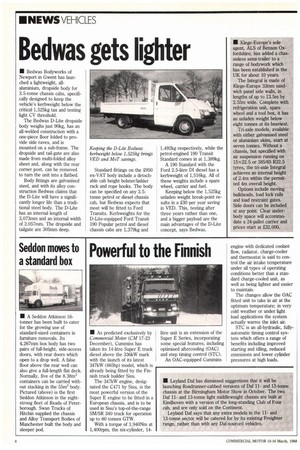Bedwas gets lighter
Page 18

If you've noticed an error in this article please click here to report it so we can fix it.
• Bedwas Bodyworks of Newport in Gwent has launched a lightweight, allaluminium, dropside body for 3.5-tonne chassis cabs, specifically designed to keep the vehicle's kerbweight below the critical 1,525kg tax and testing light CV threshold.
The Bedwas D-Lite dropside body weighs just 90kg, has an all-welded construction with a one-piece floor folded to provide side raves, and is mounted on a sub-frame. The dropside and tail-gate are also made from multi-folded alloy sheet and, along with the rear corner post, can be removed to turn the unit into a flatbed.
Body fittings are galvanised steel, and with its alloy construction Bedwas claims that the D-Lite will have a significantly longer life than a traditional steel body. The D-Lite has an internal length of 3,073mm and an internal width of 2,057mm. The dropside and tailgate are 305rnm deep.
Standard fittings on the 2950 ex-VAT body include a detachable cab height bolster/ladder rack and rope hooks. The body can be specified on any 3.5tonne petrol or diesel chassis cab, but Bedwas expects that most will be fitted to Ford Transits. Kerbweights for the D-Lite-equipped Ford Transit 190 Popular petrol and diesel chassis cabs are 1,379kg and
1,492kg respectively, while the petrol-engined 190 Transit Standard comes in at 1,389kg.
A 190 Standard with the Ford 2.5-litre DI diesel has a kerbweight of 1,516kg. All of these weights include a spare wheel, carrier and fuel.
Keeping below the 1,525kg unladen weight break-point results in a 230 per year saving in VED. This, testing after three years rather than one, and a bigger payload are the main advantages of the D-Lite concept, says Bedwas.








































































































